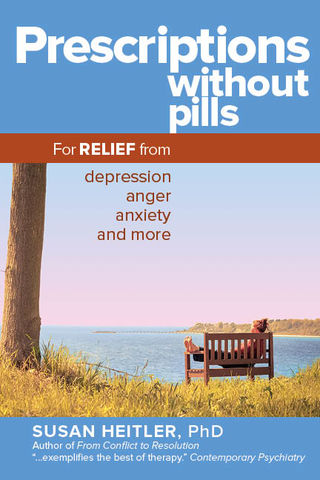Resilience
Resilience: Why It's Vital and How To Enhance It
You can't always get what you want, but resilience helps you rebound sooner.
Posted June 6, 2013

What's so important about resilience? Shakespeare wrote that the course of true love never does run smooth. The reality however is that few enterprises run smoothly. Sports errors provoke frustration. Business situations bring on disappointment. Children make mistakes. Parents lose their cool. Couples struggle with each other, creating minor marriage problems. The course of true life never does run smooth.
Resilience in individuals refers to the ability to self-soothe and spring back emotionally after a frustrating, painful or in some other way negative event so we are ready for whatever comes to us next, good or bad. Resilience in couples refers to their ability to learn, grow and heal after upsets instead of letting misunderstandings accummulate until they create big problems in marriage. No one wants excessive stress, which takes its toll on body and soul. If stressful circumstances do arise though, resilience is a huge help.
And resilience is where the 25 seconds rule comes in, but more on that phenomenon later.
Given the reality of life’s frequent challenges, how is it that some people’s lives do seem to run a lot more smoothly than others?
To some extent Lady Luck plays unfairly. All of us do from time to time run into a series of difficulties that cause us to feel bent out of shape or even flattened. Still, some people do seem to receive more than their fair share of these stretches of bad luck.
The intensity of our upset responses, and how long those negative feelings last, comes partially also from the inherent importance to us of an unfortunate event. A set-back from a minor problem with your kitchen sink is going to have less emotional impact than an infidelity, the death of a beloved family member, or a divorce. At the same time, how people respond to the challenges that confront them makes a major difference.
Cognitive-behavioral psychologists such as Aaron Beck, Albert Ellis, Martin Seligman and many others have noted that the amount of time we spend in negative states results as much from how we think about what has happened as from the actual events that occur in our lives. They describe, for instance, "catastrophizing," a habit of looking at small set-backs as momentous difficulties. They describe also the negative impacts of over-generalizing from specific difficuties. It's one thing to feel frustrated with the sink that just backed up. It's another then to generalize that "bad things always happen to me." Always and never are tip-offs of a likely over-generalizing error. Hyper-generalizing with negative generalizations about yourself like "I'm just no good at running a home," will make matters still worse.
What other patterns indicate that a person's relilience strategies need an upgrade?
A friend of mine who is a dean at a local law school shared with me recently how his graduates are faring given the difficulties of finding post-graduation employment. He described three categories of responses.
Victims felt discouraged and helpless, complaining powerlessly about how few jobs seem to be out there in this relatively slow economy, getting mad at themselves for the problems they were facing, and giving up too quickly on their post-degree goals.
Entitled folks got angry, blaming the university for not having prepared them better for the tight job market that would greet the holders of newly-minted degrees. They directed their energies toward figuring out whose fault their predicament was. They ranted to whomever would listen, and ran to find ways to get the "wrong-doers" punished.
Problem-solvers, by contrast, quickly brushed aside their initial disappointment and frustration. Instead they briefly acknowledged initial negative feelings and then quickly switched from bemoaning the tough situation to what-to-do-about-it information-gathering and creative thinking.
Guess which graduates tended to be among the first of their friends to succeed in finding post-graduate employment? Independent of how good their grades had been, group three were the likeliest front-runners. Problem-solving launches a pathway to solutions.
What are signs and skills of resilience?
Skillful emotional resilience results from two thought-patterns in particular. One is a habit of seeing situations in terms of what is good rather than just what is problematic in them. The second is rapid switching from a brief initial expression of emotions to problem-solving.
Gratitude, that is, focusing on what is good.
Problem-solvers boost their morale initially by looking for a way to see the bright side. They are experts at gratitude, using it to reframe their dilemma by looking at what they felt thankful for. I remember once watching a serious athlete take a fall that broke his elbow. As soon as he could stand up, the declaration from his lips was of genuine thankfulness. "I'm so glad it's my left elbow and I'm a rightie!"
One cognitive trick for counting blessings is to broaden your vision from your immediate difficulty to a larger picture of how it could have been worse. “Thank heavens I at least have a legal degree now! Sooner or later, when I do find a job, I'll have a fine career ahead of me." Or, "I’m so glad that I used my summers during law school to work in local law firms. Those summer experiences now give me an advantage as far as knowing people in the local legal community who might be able to help me via their contacts."
How-to Thinking
Problem-solvers in the third group of new lawyers adopted “How will I…?” as their mantra. They scanned their personal histories for ideas of what strengths and skills they could summon. They scanned the work world for opportunities by going out and talking with family friends, folks they met sitting on a bus, or anyone they stumbled upon in order to generate option ideas. That is, they stayed emotionally calm and cognitively active.

The 25 Second Challenge
I’ve learned much about rapid resilience by working as a mental coach with professional tennis players. In professional tennis, players are allowed only 25 seconds between the end of one point and the beginning of the next. The breaks between each several games in a set give them only a bit longer, just a few minutes to press their reset button. What they do in these brief interludes between plays often determine whether they will win or lose the match.
Like the victims above, even professional tennis players can be tempted to moan to themselves on how hopeless it is to play under such a hot and glaring sun, how bad their luck was in getting such a strong player to play against in their first round match, or how slowly their legs seem to be moving that day.
They may feel entitled too, thinking that they should be able to perform in tournaments at the same level as they hit in practice, and therefore getting mad at themselves for playing sluggishly or making mistakes now, when it really counts.
Winners, by contrast, spend their 25 second pauses after bad points analyzing what happened. They look back to learn in order to figure out what went wrong and what to do that might improve their situation. Instead of dwelling on how bad they feel or whose fault it was, they spring right into problem-solving mode.
If the emotion is high and negative, a player might start with some self-calming with positive thinking. "I'm glad it's still early in the match so I have time to make up for this slow start."
Then they head straight to look back to learn, clarifying what went wrong, followed by problem-solving. “What did I do that caused my volley to go into the net? My knees were stiff.” They then quickly visualize potential solutions. “I need to bend my knees more when I’m at the net so I can get below those low balls. If my body is lower it will be easier to hit slightly more upwards on the ball, and get those low volleys over the net.”
Tennis players do often feel furious at the end of a long and hard-fought point. Often that point ends badly. That's true whether the mistake was their own or by someone else like their doubles partner, their opponent or the umpire. Yet no matter what happens, players still have just 25 seconds to calm themselves, analyze what happened, plan how to self-correct, and then still have several seconds left to plan the next point. Resilience, rapid resilience, is essential.
Tennis players are ultimately just people. If they accomplish resilient recovery within just 25 seconds, then all of us can, at least if we practice it. And at least in a far briefer time than perhaps we typically have taken.
One caveat. To recover from grief or trauma, a longer process is generally appropriate. Grief seems to lift from talking about it. Thinking aloud with others about the lost loved one or situation (like a lost job) helps you package the memory for safe storage before you move on. Moving on emotionally too quickly before you take the time to digest and accept a loss, especially of someone you were close to, can be a mistake. You may need a batch of tears and helpful supportive folks to talk with before you can regain the old you. And "normal" grieving of loved ones involves waves of sadness that will continue, though with less frequency and intensitiy, over time.
Back to the Big Picture: So What is the Nature of Resilience?
In my younger days I had a philosophically-minded friend who loved to ask of many things, “What is the nature of _____?” That’s a vital question for the phenomenon of resilience. If you don’t know what resilience is, you are likely to feel less motivated to work toward gaining it, and less able to grasp it’s two key steps. So just what is the nature of resilience?
The Merriam-Webster dictionary defines resilience as the capability of a strained body to recover its size and shape after deformation caused especially by compressive stress, and as a person’s ability similarly to recover from or adjust to misfortune or change.
Emotional resilience is the sequence of mental actions that enable you, when you feel “bent out of shape,” to return to your earlier feeling that you and the world are reasonably fine.
For couples, resilience is the ability to quickly move from annoyance or frustration to figuring what to do about the problem situation. No time for attributing blame or hiding in shame. Resilience is ability to respond to disappointments and annoyances, as well as to tragedies and catastrophes, with optimally quick recovery.
At sports, at work, at home in couple and family situations, and throughout your life, resilience enables you to feel better sooner, and to solve the problem in a way that creates better fortune ahead.
--------------------

Denver clinical psychologist Susan Heitler, Ph.D. specializes in helping individuals rebound from depression and anxiety, as in her newest book, Prescriptions Without Pills.
Dr. Heitler's earlier books, The Power of Two and The Power of Two Workbook, help couples to resolve their marriage issues. Her Power of Two online alternative to couple therapy offers inexpensive help for couples who want to fix marriage problems.




